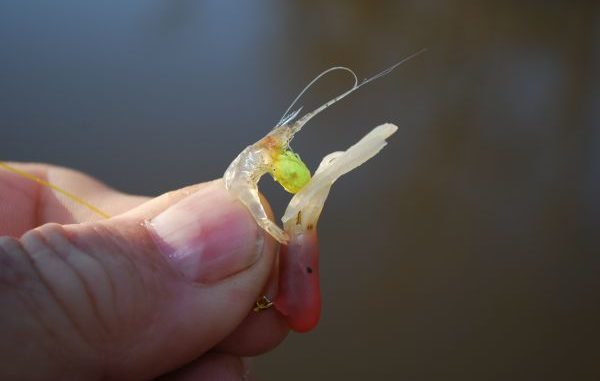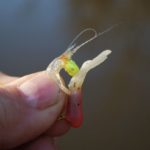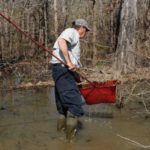
All fish love these diminutive creatures
Freshwater anglers, unlike saltwater fishermen who well know the role of shrimp in the food web of the species they pursue, mostly ignore shrimp.
Some of the best saltwater fishing lures are designed to mimic shrimp. While an argument could be made that tube jigs imitate freshwater shrimp, by and large freshwater lures are designed to look like fish, crawfish, worms, salamanders and even mice — yes mice.
Old timers can easily remember the Shakespeare swimming mouse. Some can even recall lures designed to look like swimming baby ducks. But shrimp lures — nahh.
Yet, freshwater fish eat a lot more shrimp than mice or baby ducks. As it turns out, even though most fishermen never see them, Louisiana’s fresh waters hold a lot of shrimp of several different species.
Freshwater shrimp can be divided into two groups: river shrimp and grass shrimp. River shrimp can grow larger than grass shrimp (large enough for human consumption), but their story will be left for another day.
Grass shrimp are much smaller creatures, found both in rivers and in coastal wetlands. At least five species exist in Louisiana, and all belong to the genus Palaemonetes. The scientific name has Greek roots and means “ancient one who lives alone.”
Grass shrimp are small creatures. Some species prefer totally fresh waters and others brackish waters, but dwelling on which species lives where is pointless because most fishermen don’t carry magnifying glasses around to study the bumps and spines on shrimp (or anything else). So we will lump them together as just plain grass shrimp.
One characteristic of grass shrimp is that fish love — just absolutely love — to eat them. In spite of their small size (less than 2 inches), big fish eat them like elephants eat peanuts, and for smaller fish, they are just perfect bite-size.
Six-pound bass attack them. So do 50-pound blue catfish. White bass chomp on them as well as river shrimp. Bluegill adore them and redear sunfish, called lake runners north of Lake Pontchartrain and chinquapin everywhere else, will gorge on them until their bellies swell like balloons.
“Good ole country boys” have used river shrimp as bait for a long time, but recently the Internet has carried a lot of buzz from the high-performance fiberglass-boat crowd about the marvelous “new” bait, speaking of them in almost reverential whispers.
Fact is, they can save the day for properly prepared freshwater fishermen who know where to look for them. Properly prepared simply means carrying a very fine-meshed dip net and bucket in the boat and knowing where to look for the little critters.
They are most common in moderate to dense growths of submerged plants. In winter months when submerged plants are scarce, they can be found in areas with lots of tree leaf litter on the bottom, and they can be very common where rising water levels have submerged shore-side grasses. They are always most common in water less than 2 feet deep.
Unlike river shrimp, grass shrimp dislike water current and are most often found in areas of gentle or no water movement.
In spots with modest or little plant growth, the dip net should be vigorously worked over the bottom. In areas with dense plants, the dip net is scooped under the plants and then gently retrieved to within hand reach of the dipper, where the plants are strongly shaken over the net to dislodge the little shrimp.
Either way, the net’s contents are dumped into the bucket, and then the shrimp are sorted from the debris.
Live grass shrimp are transparent and a little difficult for the untrained eye to see.
Dipping is most successfully done early in the morning, under low light conditions. Grass shrimp are most active at night, and during the day they tend to hug bottom or bury in bottom debris.
As could be expected of something that everything bigger loves to eat so much, grass shrimp are short-lived. An old one is 13 months old.
Spawning takes place from March to October. The young spawned in the spring will be mature enough to reproduce in the fall. The young spawned in the fall will spawn the following spring, if something doesn’t eat them first.
Spawning takes place when a mature female has shed her shell and during the seven hours that she is in the soft-shell stage. A male shrimp positions himself to extrude a sperm package and attach it to a spot near her vent. When her shell hardens and she lays her eggs, the sperm package dissolves and the sperm fertilizes her eggs.
The fertilized eggs will stick to the tiny, hair-like swimmerets beneath her tail. Here, she will brood the eggs and then the larvae for up to two months. The eggs and larvae under the tail are easily visible to the human eye.
Researchers have noted that grass shrimp are good biological indicators of pollution, generally being more sensitive than fish to the presence of heavy metals and most pesticides.
One last tip for anglers who want to learn to use grass shrimp for bait is to bring a container of corn meal in the boat. Grass shrimp are very difficult to keep alive. When they die, they rapidly turn from transparent to white and are nearly useless as bait. For some reason, unknown to me, grass shrimp will live for hours mixed in a container of corn meal. And when they do die, they don’t immediately turn white.




